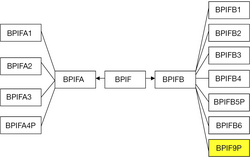Biology:BPIFB9P
 Generic protein structure example |
Vomeromodulin is a non-human protein also known as BPI fold containing family B, member 9 (BPIFB9) in the rat encoded by the Bpifb9/RYF3 gene,[1][2] and as BPI fold containing family B, member 9A (BPIFB9A) encoded by the Bpifb9a gene in the mouse.[3] This protein has been characterized in mammals such as rodents, carnivores, even-toed ungulates, insectivores, bats, lagomorphs, and shrews[4] but is apparently absent in primates and other vertebrates such as birds, reptiles, and amphibians. Its function is associated with detection of chemical odorant pheromone molecules.
In humans no protein is expressed and it is present only as a pseudogene BPIFB9P.[5] The pseudogene was named based on its functional ortholog found in the other species.[6]
Superfamily
Vomeromodulin/BPIFB9/BPIFB9A is a member of the BPI fold protein superfamily defined by the presence of the bactericidal/permeability-increasing protein fold (BPI fold) which is formed by two similar domains in a "boomerang" shape.[7] This superfamily is also known as the BPI/LBP/PLUNC family or the BPI/LPB/CETP family.[8] The BPI fold creates apolar binding pockets that can interact with hydrophobic and amphipathic molecules, such as the acyl carbon chains of lipopolysaccharide found on Gram-negative bacteria, but members of this family may have many other functions.
Genes for the BPI/LBP/PLUNC superfamily are found in all vertebrate species, including distant homologs in non-vertebrate species such as insects, mollusks, and roundworms.[9][10] Within that broad grouping is the BPIF gene family whose members encode the BPI fold structural motif and are found clustered on a single chromosome, e.g., Chromosome 20 in humans, Chromosome 2 in mouse, Chromosome 3 in rat, Chromosome 17 in pig, Chromosome 13 in cow. The BPIF gene family is split into two groupings, BPIFA (SPLUNC) and BPIFB (LPLUNC). In humans, BIPFA consists of 3 protein encoding genes BPIFA1, BPIFA2, BPIFA3, and 1 pseudogene BPIFA4P; while BPIFB consists of 5 protein encoding genes BPIFB1, BPIFB2, BPIFB3, BPIFB4, BPIFB6 and 2 pseudogenes BPIFB5P, BPIFB9P. What appears as pseudogenes in humans may appear as fully functional genes in other species.
The PIFB9P pseduogene in humans was first reported in 2011 as a member of the BPI/LBP/PLUNC family,[11][10] but clones containing PIFB9P had been detected in 1999 genomic screening by the Welcome Trust Sanger Institute.[12]
Function
In humans, the expression of the BPIFB9P pseudogene into functional BPIFB9 protein is unclear. Although identified multiple times by independent scientists as a pseudogene not capable of coding for a protein, its gene sequence may predict two transcripts (splice variants) [13] and RNA transcripts detected by RNA-Seq screens have been observed in brain tissues, striated muscle, white blood cells (granulocytes, monocytes), and esophageal mucosa.[14] Yet, definitive evidence for human BPIFB9 protein has never been produced and is unlikely to happen.
The non-human version of this protein, however, is well known. Vomeromodulin is highly expressed in nasal mucosa, particularly within a structure known as the Vomeronasal organ.[15] The vomeronasal organ is present and well-developed in many mammals to process pheromone odors into neural signals to the brain, but the chemical and neural components of the vomeronasal system have been completely inactivated in most primates, including humans. [16][17] In this context, BPIFB9-type proteins are thought to be similar to odorant binding proteins which presents odorant molecules to chemical odorant receptor molecules.[18] Those odorant receptors, in turn, are associated with nasal epithelial cells integrated with olfactory neurons that project back to the brain's oflactory areas and hypothalamus. It has been established that the genes and proteins for these components are present and active in many mammal species, but in higher primates the genes are found to be mutated and appear as non-functional pseudogenes, like BPIFB9P.
References
- ↑ "Novel genes for potential ligand-binding proteins in subregions of the olfactory mucosa". The EMBO Journal 10 (10): 2813–9. October 1991. doi:10.1002/j.1460-2075.1991.tb07830.x. PMID 1915264.
- ↑ "R.rattus RYF3 mRNA for a potential ligand-binding protein". 7 October 1991. https://www.ncbi.nlm.nih.gov/nuccore/X60659.1. "Accession X60659.1"
- ↑ "Bpifb9a BPI fold containing family B, member 9A [Mus musculus (house mouse) - Gene - NCBI"]. https://www.ncbi.nlm.nih.gov/gene/71425.
- ↑ "vomeromodulin - Protein - NCBI". https://www.ncbi.nlm.nih.gov/protein/?term=vomeromodulin. "See: "Results by taxon""
- ↑ "BPIFB9P BPI fold containing family B member 9, pseudogene [Homo sapiens (human) - Gene - NCBI"]. https://www.ncbi.nlm.nih.gov/gene/402016.
- ↑ "Symbol report for BPIFB9P". HUGO Gene Nomenclature Committee. https://www.genenames.org/data/gene-symbol-report/#!/hgnc_id/HGNC:16109.
- ↑ "The BPI/LBP family of proteins: a structural analysis of conserved regions". Protein Science 7 (4): 906–914. April 1998. doi:10.1002/pro.5560070408. PMID 9568897.
- ↑ "CDD Conserved Protein Domain Family: BPI". https://www.ncbi.nlm.nih.gov/Structure/cdd/cddsrv.cgi?uid=cl00188.
- ↑ "Detecting distant relatives of mammalian LPS-binding and lipid transport proteins". Protein Science 7 (7): 1643–1646. July 1998. doi:10.1002/pro.5560070721. PMID 9684900.
- ↑ 10.0 10.1 "Systematic nomenclature for the PLUNC/PSP/BSP30/SMGB proteins as a subfamily of the BPI fold-containing superfamily". Biochemical Society Transactions 39 (4): 977–983. August 2011. doi:10.1042/BST0390977. PMID 21787333.
- ↑ "Distant cousins: genomic and sequence diversity within the BPI fold-containing (BPIF)/PLUNC protein family". Biochemical Society Transactions 39 (4): 961–965. August 2011. doi:10.1042/BST0390961. PMID 21787330.
- ↑ "Homo sapiens chromosome 20 clone RP5-1068H6, WORKING DRAFT SEQUENCE, 41 unordered pieces". 2 February 2000. https://www.ncbi.nlm.nih.gov/nuccore/AL117331.1?report=genbank.
- ↑ "Gene: BPIFB9P (ENSG00000125997) - Splice variants - Homo_sapiens - Ensembl genome browser 109". https://useast.ensembl.org/Homo_sapiens/Gene/Splice?db=core;g=ENSG00000125997;r=20:33347720-33354444.
- ↑ "Gene : BPIFB9P - ENSG00000125997". The Bgee suite: integrated curated expression atlas and comparative transcriptomics in animals. https://bgee.org/gene/ENSG00000125997/.
- ↑ "Expression of the putative pheromone and odorant transporter vomeromodulin mRNA and protein in nasal chemosensory mucosae". Journal of Neuroscience Research 39 (3): 243–259. October 1994. doi:10.1002/jnr.490390303. PMID 7869418.
- ↑ "The evolution of pheromonal communication". Behavioural Brain Research 200 (2): 239–247. June 2009. doi:10.1016/j.bbr.2008.09.039. PMID 18977248. https://researchonline.ljmu.ac.uk/id/eprint/1367/1/Swaney%20evol%20pherom%20comm%20accepted.pdf.
- ↑ "Vomeronasal organ and human pheromones". European Annals of Otorhinolaryngology, Head and Neck Diseases 128 (4): 184–190. September 2011. doi:10.1016/j.anorl.2010.11.008. PMID 21377439. "Elsevier open access".
- ↑ "The 40-Year Mystery of Insect Odorant-Binding Proteins". Biomolecules 11 (4): 509. March 2021. doi:10.3390/biom11040509. PMID 33808208.
External links
- Human BPIFB9P genome location and BPIFB9P gene details page in the UCSC Genome Browser.
 |


